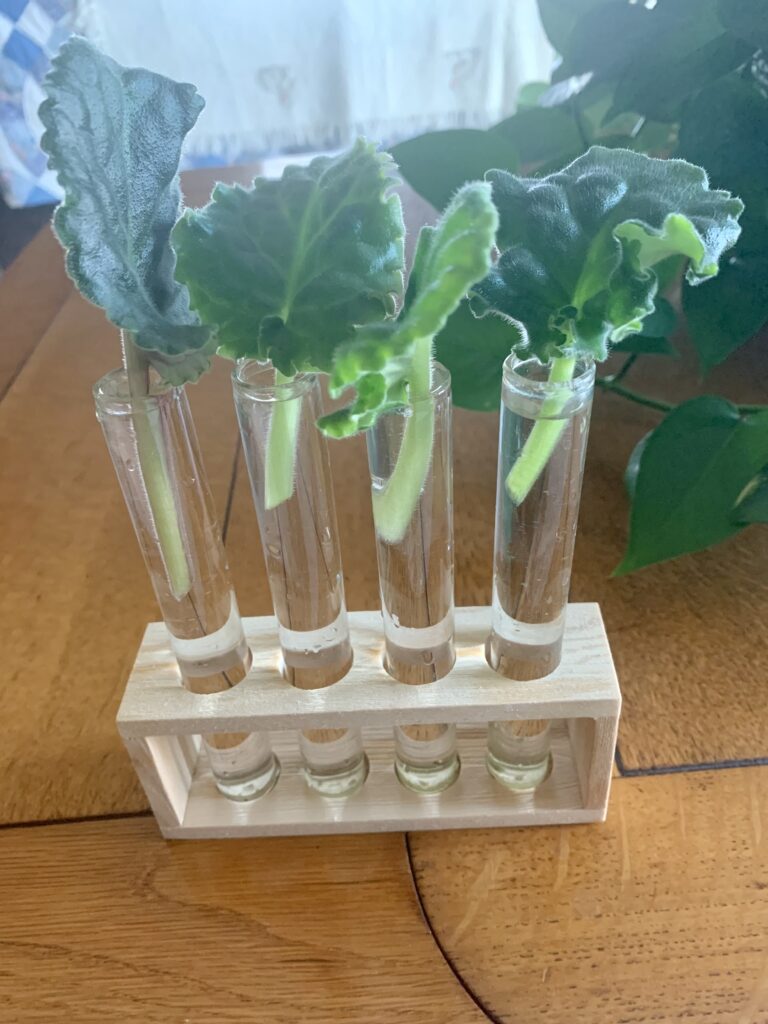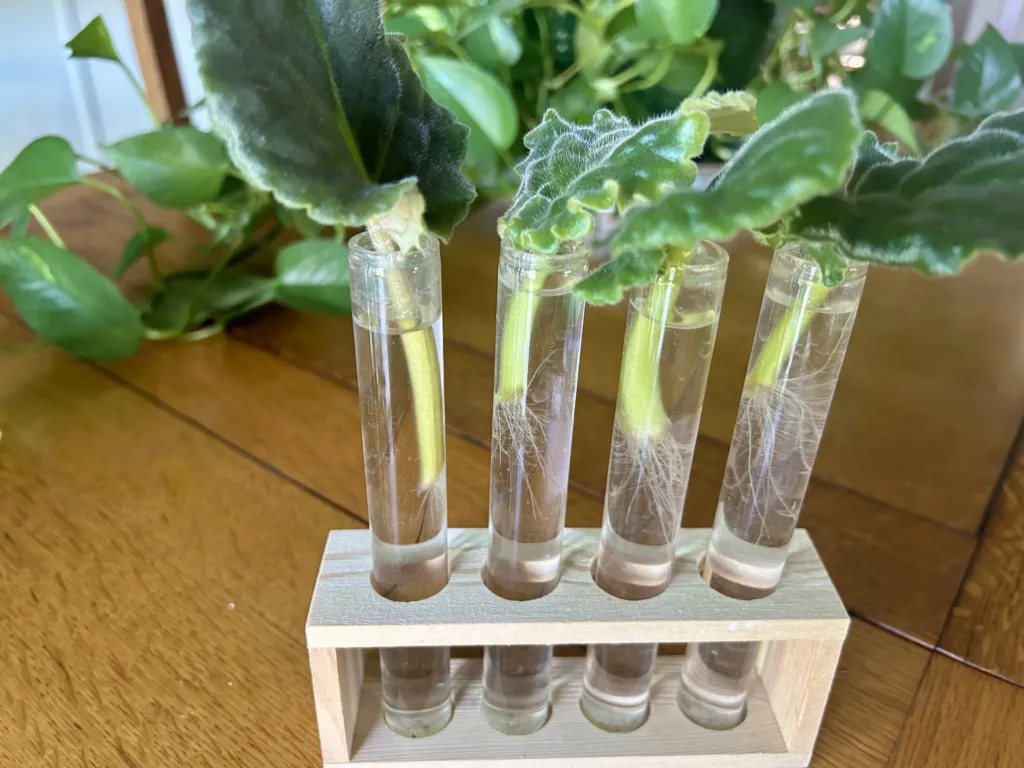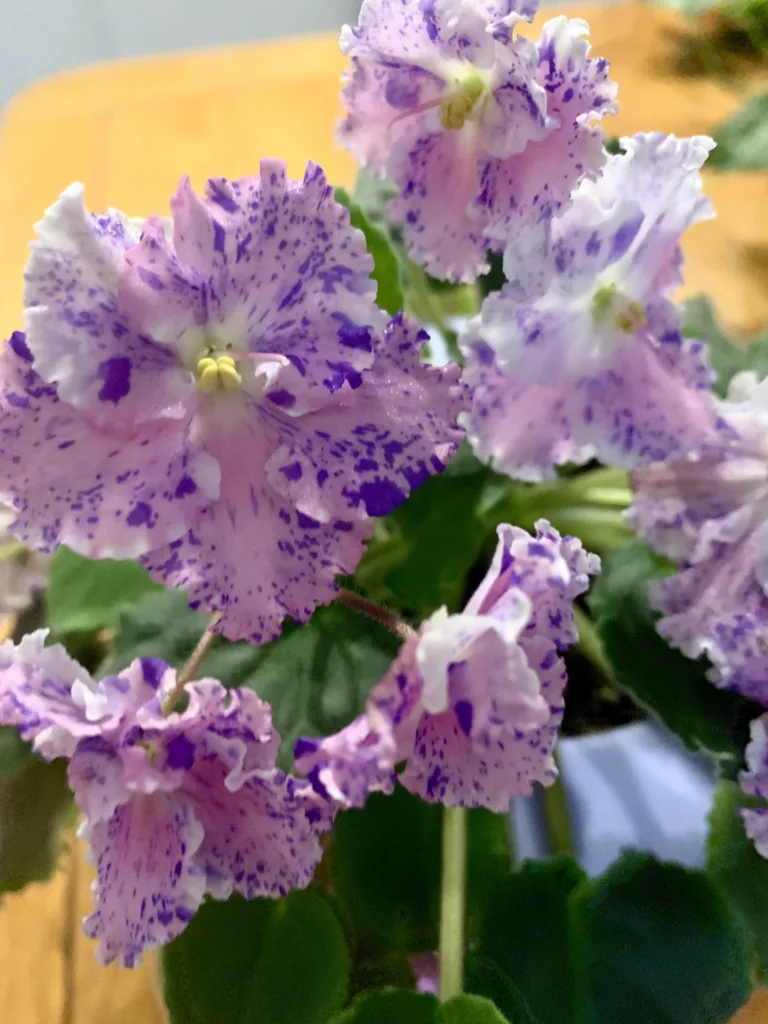African Violets (Saintpaulia) are a popular indoor plant because of their stunning blooms and unique leaves. When you know how all the tips and tricks to care for them properly they are easy to grow. Many gardeners want to propagate their African violets to create more plants inexpensively and share them with family and friends. In this blog post, we will discuss African Violet propagation, specifically leaf propagation and step-by-step guide.
Propagating by Leaf Cutting in Soil
Leaf cutting is one of the most common methods for propagating African violet plants. To do this, you’ll need a healthy leaf and a sterile cutting tool. Follow these steps for successful propagation:
- Choose a healthy leaf: Select a mature leaf from your African violet plant, preferably one that is sturdy and lush green. Avoid leaves that show signs of disease or stress.
- Make a clean cut: Using a sterile knife or pair of scissors, cut the leaf stem at a 45-degree angle. This increases the surface area for roots to develop.
- Prepare the growing medium: Fill a small pot with a sterile, well-draining potting mix, such as an African violet mix or perlite.
- Plant the cutting: Push the cut end of the leaf stem, dip in rooting hormone powder and plant about 1 inch into the soil. Position the leaf to stand upright.
- Provide the right conditions: Place the pot in a warm, bright spot but out of direct sunlight. Keep the soil consistently moist but not waterlogged.
Within a few weeks, you should see new plantlets emerging from the soil. This method may require some patience, but it’s an effective way to multiply your African violet collection. Remember, the healthier the parent leaf, the more successful the propagation will be.
Propagating by Leaf Cutting in Water
Another method for propagating African Violets is through water propagation. This method is especially beneficial for those who wish to visually monitor the root development. Here’s how to do it:
- Choose a healthy leaf: Much like the soil method, select a mature, healthy leaf from your African Violet. A good leaf will increase the chance of successful propagation.
- Make a clean cut: With a sterile cutting tool, cut the leaf stem at a 45-degree angle. This will provide a larger surface area for root development.
- Prepare a water container: Find a small glass vase or propagation station for multiple leaves and fill it with filtered or distilled water.
- Position the leaf: Place the cut end of the leaf stem into the water, making sure the leaf itself does not touch the water.
- Provide the right conditions: Position the container in a warm, bright area but away from direct sunlight. Change the water every one to two weeks to keep it fresh.
In a few weeks, you should notice roots starting to form. Once the roots are about an inch long, you can transfer the new plant to a pot filled with African Violet potting mix. Like the soil propagation method, the water method also requires patience, but it provides the joy of watching the root development process.

Rooting Hormones: Pros and Cons
Rooting hormones can be an advantageous tool when propagating African Violets, but they also come with some considerations.
Pros
- Increased Success Rate: Rooting hormones can significantly improve the chances of successful propagation. They contain auxins, a type of plant hormone that stimulates root growth. This can be particularly beneficial when propagating a difficult or finicky plant.
- Faster Root Development: Rooting hormones can expedite the process of root formation. This could mean a shorter wait time before you can repot your new African Violet plant.
- Stronger Plants: The plants propagated with rooting hormones often develop a robust root system, which can lead to healthier, more resilient African Violets.
Cons
- Possible Health Risks: Some rooting hormones contain synthetic chemicals that can be harmful if not used properly. It’s important to follow the product instructions closely and to keep the product out of reach of children and pets.
- Unnecessary for Some Plants: Not all plants require rooting hormones for successful propagation. African Violets, in particular, are often able to root well on their own.
- Additional Cost: Although relatively inexpensive, rooting hormones do represent an additional cost. Depending on how often you propagate plants, this can add up.
In conclusion, while rooting hormones can increase the success rate and speed of African Violet propagation, they are not always necessary. It’s a personal decision whether to use them, based on your own propagation needs and preferences.
Removing the Mother Leaf: When and How
Once you start seeing a clump of leaves forming on the new plant, it signifies successful propagation. This usually happens after several weeks but can vary based on conditions. However, don’t be in a rush to remove the mother leaf. This leaf is still providing the new plantlets with much-needed nutrients.
The best time to remove the mother leaf is when the new plantlets have established their own strong root system. This usually happens when they’ve grown three to five leaves of their own. At this point, the new African Violet is capable of sustaining itself, and the mother leaf can be cut off.
To remove the mother leaf, use a sharp, sterile knife or pair of scissors. Make a clean cut as close to the base of the stem as possible, taking care not to damage the new plant. Remember to handle your new African Violet delicately to avoid causing any trauma. This is an exciting time in the propagation process and a sign that you are close to having a fully independent new plant.
Choosing the Right Pot Size for New Leaf Start and When to Upsize
When it comes to planting your new African Violet leaf start, choosing the right pot size is crucial. Ideally, the initial pot should be relatively small – usually around 2 to 3 inches in diameter. Smaller pots help maintain a favorable root-to-soil ratio and encourage the development of a robust root system.
As the new plant grows, it will eventually require a larger pot. Typically, the time to move up in size is when the width of the plant reaches approximately one-third the diameter of the current pot. Alternatively, you can observe the root system; if the roots are becoming crowded and starting to circle the bottom or sides of the pot, it’s a clear sign that repotting is needed.
When upsizing, don’t go too big too soon. A common mistake is to move the plant to a significantly larger pot, thinking it will allow the plant to grow bigger and faster. However, a pot that is too large can lead to waterlogging and root rot, as the soil will stay wet longer than necessary. A good rule of thumb is to move up to a pot that is 1 to 2 inches larger in diameter than the current one.
Remember, every plant is unique and may grow at a different pace. Always monitor your African Violet’s growth and adjust accordingly. Regular repotting not only prevents the plant from becoming root-bound but also provides fresh soil and nutrients, contributing to a healthier, more vibrant African Violet.
Happy Gardening!
African violets are a perfect plant for those who want to propagate and increase their collection. With the different methods of propagation available, you can easily produce new plants from the parent plant. Whether you prefer leaf cutting or crown division, these methods are easy to do, and with a little patience, you can grow healthy and beautiful African violets.
Please be sure to check out my Gardening Blog Post Page for more tips on all types of gardening. Including Seed Saving, Seed Starting, Orchids, Water Gardening, Coldframe Gardening, Indoor Bulb Gardening, Hydroponics, Container Gardening, Mums, Herbs, African Violets, planting Bulbs, Flower Gardening, Vegetable and Fruit Gardening, Indoor Houseplants of all kinds, Cactus, Succulents, Hanging plants, Deer resistant plants and even Bird, Bee, Butterfly and Hummingbird Gardens!


